
The ACE Integrated Fitness Training® (ACE IFT®) Model is a comprehensive system for exercise programming that pulls together the multifaceted training parameters required to be a successful personal trainer. It organizes the latest exercise science and health behavior research into a systematic approach to designing, implementing and modifying exercise programs based on the unique abilities, needs and goals of each individual.
Since its launch in 2010, the ACE IFT Model has evolved to incorporate new evidence-based practices in exercise programming. It has also evolved, based on user feedback, into a model that is just as robust in terms of science, content and comprehensive programming, while being simplified in its presentation and terminology. This article summarizes the Cardiorespiratory and Muscular Training components of the ACE IFT Model found in the recently published The Exercise Professional’s Guide to Personal Training – A Client-Centered Approach to Inspire Active Lifestyles.
Introduction to the ACE Integrated Fitness Training Model
The ACE IFT Model provides health and exercise professionals with tools and methods to help clients make fitness-related behavior changes that facilitate physical-activity participation and adherence to make lasting improvements in health and well-being. The ACE IFT Model has two training components:
- Cardiorespiratory Training
- Muscular Training
Each training component has three phases that are named to reflect the training focus of each phase. The two training components of the ACE IFT Model are based on evidence-based exercise programming (see sidebar) and progressions, and associated fitness and functional assessments, that produce physiological adaptations to exercise that improve function, health, fitness and performance. The training components are independent of each other, allowing for the integration of any Cardiorespiratory Training phase with any Muscular Training phase to meet the personalized health and fitness goals of each client.
ACE IFT Model Research
An ACE-commissioned research study demonstrated that personalized exercise programming using the ACE IFT Model brings about significantly greater improvements in cardiorespiratory fitness, muscular fitness and key cardiometabolic risk factors compared to standardized exercise programming. Researchers concluded that “these novel findings are encouraging and underscore the importance of personalized exercise programming to enhance training efficacy and limit training unresponsiveness.”
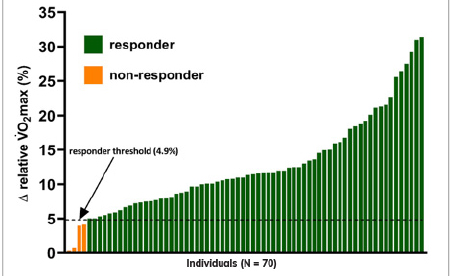
Figure 1
More recently, personalized exercise programming with the ACE IFT Model has been shown to significantly increase cardiorespiratory fitness and cardiometabolic health training responsiveness compared to a standardized exercise program. Indeed, the incidence of maximal oxygen uptake (VO2max responders) (Figure 1) and metabolic syndrome (MetS) z-score (Figure 2) responders to the ACE IFT Model exercise training program were 94% and 80%, respectively.
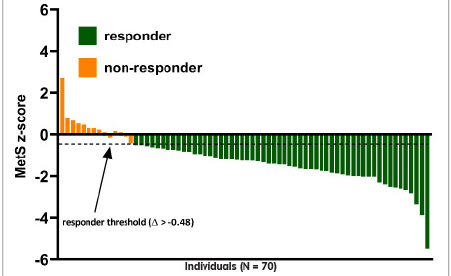
Figure 2
ACE Integrated Fitness Training Model—Cardiorespiratory Training
The Cardiorespiratory Training component of the ACE IFT Model is divided into three phases, each with a title that defines its training focus (Figure 3):
- Base Training
- Fitness Training
- Performance Training

Figure 3
ACE Integrated Fitness Training Model – Cardiorespiratory Training
Client goals are based on current health status, fitness levels and individual preferences. By utilizing the assessment and programming tools for each phase, you can develop personalized cardiorespiratory programs for all types of clients, from physically inactive individuals to endurance athletes. Of course, not every client will start in the same phase of training, as many clients will already be regularly participating in cardiorespiratory exercise, and only clients with very specific performance-related objectives will reach the Performance Training phase. Programming within each phase of the Cardiorespiratory Training component is based on the three-zone intensity model using the talk test and heart rate (HR) at the first ventilatory threshold (VT1) and second ventilatory threshold (VT2) to develop personalized programs based on each client’s metabolic responses to exercise (Figure 4).

Figure 4
Three-zone intensity model
It is important to note that you can implement the training principles in the ACE IFT Model’s Cardiorespiratory Training phases by using various exercise intensity markers, including ones based on predicted values such as percentage heart-rate reserve (%HRR) or percentage maximal heart rate (%MHR), but the exercise intensities will not be as accurate for individual clients as they would be if you utilize measured HR at VT1 and VT2 (Table 1).
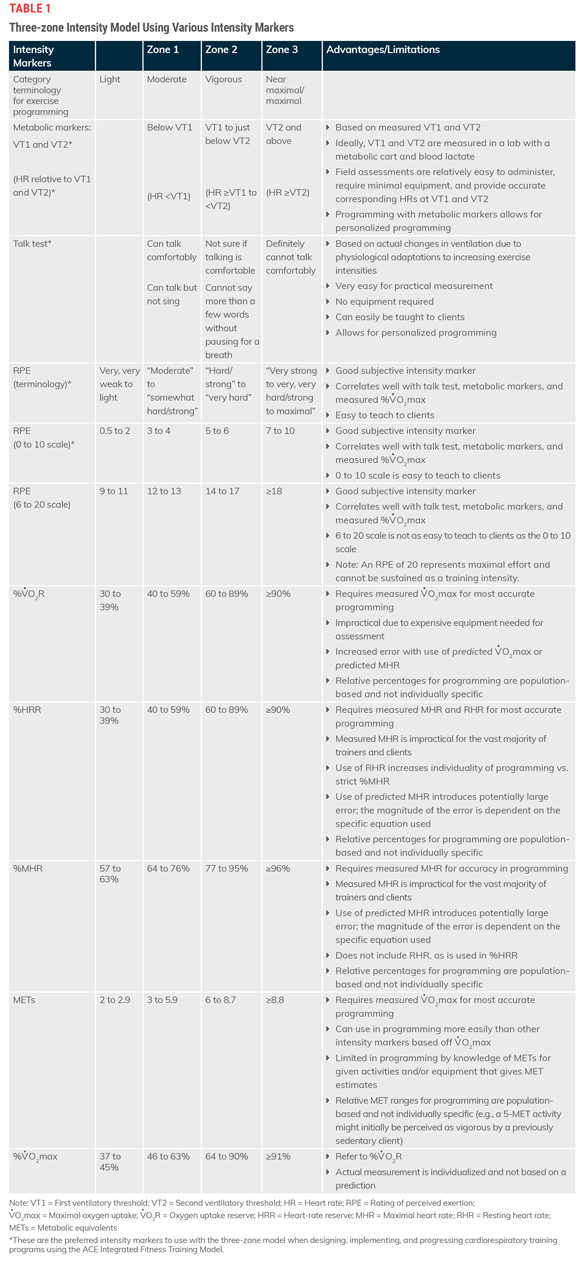
The submaximal talk test for VT1 and the VT2 threshold assessment give fairly precise HR data that relates directly to the VT1 and VT2 metabolic markers. The submaximal talk test for VT1 can provide you with the client’s HR at VT1 to use when designing programs for improving general fitness. The higher-intensity VT2 threshold assessment allows you to establish the client’s HR at VT2 for use in more advanced programming with clients who have performance goals related to fitness and/or endurance sports. (ACE Certified Pros can download the bonus content, which includes forms to use with your clients and describes in detail how to administer the talk test assessment.)
Base Training
The exercise programming in the Base Training phase is intended to help clients move more consistently to establish basic cardiorespiratory endurance. This, in turn, leads to improved overall health, energy and mood, and increased caloric expenditure. Encouragement and exercise activities that can be successfully completed in each workout are crucial for building client self-efficacy in this phase.
Any client who is not already consistently performing moderate-intensity cardiorespiratory exercise should begin with Base Training. As such, the goal for all clients in Base Training is to gradually increase exercise duration and frequency until the client is performing cardiorespiratory exercise three to five days per week for a duration of 20 minutes or more. No cardiorespiratory assessments are recommended during the Base Training phase, as many clients who start in this phase will be unfit and may have difficulty completing an assessment of this nature. You can learn more about a client’s current cardiorespiratory exercise participation during the investigation stage of the client–personal trainer relationship.
The easiest method for monitoring intensity with clients during Base Training is to use the informal talk test. If the client can perform the exercise and talk comfortably, he or she is likely below the first ventilatory threshold (VT1). By exercising below VT1, clients should be exercising at a moderate intensity classified by a rating of perceived exertion (RPE) of 3 to 4.
Fitness Training
Clients in the Fitness Training phase generally have a wide variety of goals. Those looking to improve fitness and overall health can benefit from increased exercise frequency, duration and the introduction of intervals.
Both new and existing clients who can consistently perform moderate-intensity cardiorespiratory exercise for bouts of 20 minutes or more on at least three days per week can perform cardiorespiratory Fitness Training. This phase is focused on enhancing the client’s aerobic efficiency by progressing the program through longer sessions, more frequent sessions when possible, and by integrating exercise performed at and above VT1 to just below VT2.
You may have clients take the more formal submaximal talk test for VT1 during this phase, and the results may be used to personalize the client’s exercise recommendations for Fitness Training. The inclusion of zone 2 cardiorespiratory exercise performed at and above VT1 to just below VT2 allows you to blend moderate-intensity exercise (below VT1; RPE = 3 to 4) with vigorous-intensity exercise (at or above VT1 to just below VT2; RPE = 5 to 6) in a client’s program to add variety to individual sessions and to increase the intensity of the workouts to bring about greater improvements in the client’s fitness level. By providing clients with intervals that offer increased yet achievable challenges, you can help your clients simultaneously increase both fitness and self-efficacy.
Performance Training
Individuals who progress to Performance Training typically have goals that are focused on success in endurance sports and events. The training program progresses beyond the outcomes of fitness to focus on performance through increased speed, power and endurance.
Performance Training requires adequate training volume to prepare clients to comfortably complete their events. To help clients achieve higher-level performance goals, design programs that continue to build on moderate- and vigorous-intensity exercise, while integrating zone 3 intervals that push clients up to and beyond VT2, where efforts are of very high intensity (RPE = 7 to 10) and short duration. To program effective intervals, administer the VT2 threshold assessment to determine the client’s HR at VT2.
A summary of the programming guidelines for the Cardiorespiratory Training component of the ACE IFT Model is presented in Table 2.
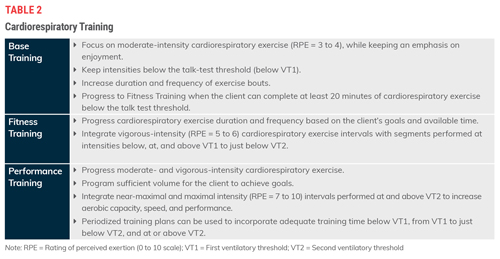
ACE Integrated Fitness Training Model—Muscular Training
The Muscular Training component of the ACE IFT Model provides a systematic approach to training that starts with helping clients improve poor postural stability and kinetic chain mobility, and then incorporates programming and progressions to help people train for general fitness, strength, body building and athletic performance. While many clients will not progress to training for athletic performance, using a training model that provides you with the knowledge and tools to work with clients across a broad spectrum of movement skills and challenges is empowering.
The ACE IFT Model Muscular Training component is divided into three phases, each with a title that defines its training focus (Figure 5):
- Functional Training
- Movement Training
- Load/Speed Training
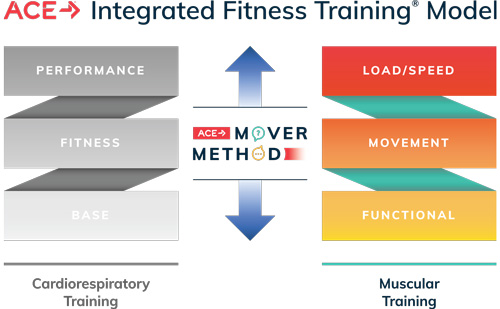
Figure 5
ACE Integrated Fitness Training Model – Muscular Training
Functional Training
Functional Training focuses on the Muscular Training goals of establishing or, in many cases, reestablishing postural stability and kinetic chain mobility by introducing exercise programs that improve joint function though improved muscular endurance, flexibility, core function, dynamic balance and static balance. This basic muscular function is typically gained as part of normal child development. Unfortunately, physical inactivity coupled with an increasingly technology-driven world has resulted in more adults having compromised posture, balance and muscular function.
When it comes to exercise selection for Functional Training, focus on core and balance exercises that improve the strength and function of the muscles responsible for stabilizing the spine and center of gravity during static positions and dynamic movements. Initially, the exercises for Functional Training use primarily body weight or body-segment weight resistance. As clients progress to Movement Training and Load/Speed Training, it is important to continue to include Functional Training exercises in their workouts. These can be included as part of either the warm-up or cool-down, or by incorporating progressions that increase the challenge of the Functional Training exercises by increasing the resistance or balance challenges.
Movement Training
The primary focus of Movement Training is to help clients move efficiently in all planes of motion without compromising postural or joint stability. Movement Training focuses on the five primary movement patterns:
- Bend-and-lift movements: These movements are performed throughout the day as a person sits, stands or squats down to lift an object off the floor.
- Single-leg movements: These movements involve single-leg balance and movement as performed during walking or going up and down stairs. In addition, lunging movements are performed when a person steps forward to reach down with one hand to pick up something small off the floor.
- Pushing movements: These upper-body movements occur in four primary directions: forward (e.g., during a push-up), overhead (e.g., lifting something to a high shelf), lateral (e.g., lifting one’s torso when getting up from a side-lying position) and downward (e.g., pushing oneself up and out of the side of a swimming pool).
- Pulling movements: These movements occur during exercises like a seated row or pull-up, or when opening a car door or picking up a child.
- Rotational movements: These movements often occur in the torso as force transfers from the legs to the arms (e.g., throwing a ball) or during twisting movements like a dancer performing pirouettes.
Movement Training exercises should emphasize the proper sequencing of movements and control of the body’s center of gravity throughout the normal range of motion. Be sure to integrate Functional Training exercises into Movement Training programs to help clients maintain and improve postural stability and kinetic chain mobility, as these are essential for performing the five primary movement patterns well.
One option for including Functional Training exercises is to add them to the warm-up to prepare the body for the more rigorous movements that follow. Body-weight exercises are often used initially during Movement Training, with external resistance used to build muscular endurance with an emphasis on controlled motion. Make sure that clients can perform the five primary movement patterns well before adding external loads to the movement patterns to decrease the risk of injury that can result from loading poor movements.
Load/Speed Training
The broad focus of Load/Speed Training is on applying external loads to movements that create a need for increased force production that results in muscular adaptations. Loads can be applied through resistance training, high-intensity interval training (HIIT), speed work, plyometrics, power lifting and other sport-specific resistance (e.g., using swim training paddles or pedaling large gears while cycling uphill).
As with Movement Training, integrate Load/Speed Training with Functional Training exercises to help clients maintain and enhance postural stability and kinetic chain mobility to adequately support the increased workloads and force production. Load/Speed Training also integrates the five primary movements that were the focus of Movement Training, emphasizing loading the movements through different planes of motion, angles, speeds and combined movements (e.g., lunge with a rotation and kettlebell swing).
Clients can reach a variety of individual goals through Load/Speed Training. Fitness-related goals for this type of training include muscular strength, muscular endurance, muscle hypertrophy and positive changes in body composition. You can help clients reach their fitness-related Load/Speed Training goals by designing exercise programs that incorporate appropriate resistance-training variables, including exercise selection and the frequency and intensity with which each exercise is performed.
Clients who have athletic performance goals can benefit from training that builds speed, agility, quickness and power. Before advancing to training for athletic performance goals, however, clients should consistently exhibit good postural stability, kinetic chain mobility and movement patterns. Clients should also have a good foundation of muscular strength to produce and control the force generated during athletic performance–focused exercises and drills. For these programs, power lifting, plyometrics, speed work and drills for agility, coordination and quickness are effective for improving athletic performance.
A summary of the programming guidelines for the Muscular Training component of the ACE IFT Model is presented in Table 3.

Applying the New ACE IFT Model
Meeting each client's personalized goals can be both a daunting yet welcome challenge. The ACE IFT Model's evidence-based and systematic approach to designing, implementing and modifying exercise programs makes it possible for you to take into account the unique abilities, needs and goals of each client. Whether you are newly certified or an industry veteran, the ACE IFT Model is a proven way for you to create safe and effective programming for your clients.
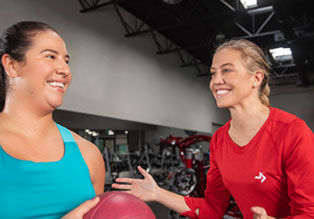
July 15, 2020 11:00 AM - 12:00 PM PDT
Presented by ACE experts, this FREE one-hour video training is your introduction to the ACE IFT® Model and how you can apply it in your training sessions right now. Discover how this all-encompassing model provides the blueprint for a client-centered approach that exercise professionals can use to design, implement, and modify exercise programs that improve posture, movement, flexibility, balance, function, cardiorespiratory fitness and muscular fitness for all clients.

 by
by 











